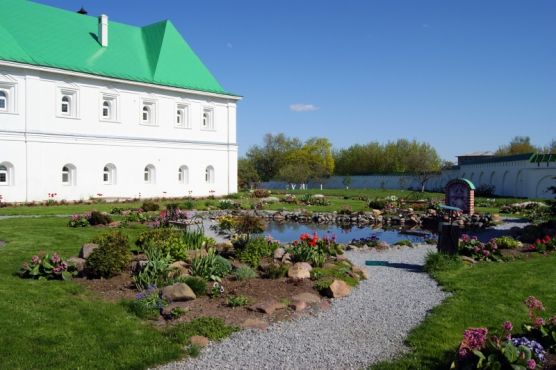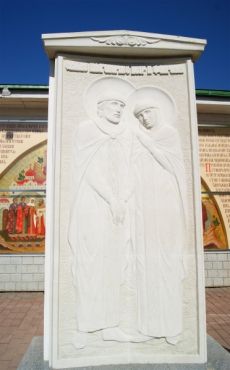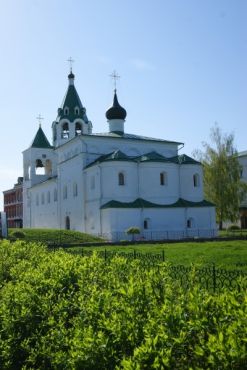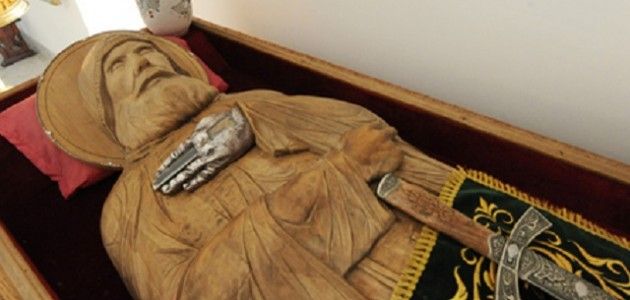Savior-Transfiguration Monastery
- Address:
- Murom, Lakina street, 1a
- GPS:
- 55.57286072, 42.06669758
- Phones:
- +7 (49234) 3-14-76
At the beginning of the 11th century, Murom was already one of the significant cities on the outskirts of the young Russian state. The Kiev prince Vladimir Svyatoslavich (the Red Sun) bequeathed it "as an appanage" to his son Gleb. And for his son Boris the prince bequeathed the town of Rostov.
"The Tale of the Establishment of Christianity in Murom" (the 16th century), a unique chronicle of the history of Murom since ancient times, gives interesting information about the Gleb's reign. A model Christian, Gleb began his reign in Murom with an attempt to convert local residents into Christianity, which the Murom pagans opposed. Gleb was forced to leave Murom and settled two versts away from it, on the steep, forested bank of the Oka, where in his fortified courtyard he founded the first church on the Murom land in the name of the Savior. This is supposedly just the place where the Savior (Spassky, Spaso-Preobrazhensky) monastery now stands, which got its name from the church founded by Gleb.
The Savior (Spassky) monastery is mentioned by chronicles before all other monasteries in Russia. The "Tale of Bygone Years" refers to the death of Prince Izyaslav Vladimirovich (Prince of Murom 1095-1096, the second son of Vladimir Monomakh and Gita of Wessex) in 1096 under the walls of Murom and his burial in the monastery of the Savior. The second mention of the Savior Monastery in the annals is associated with the burial in its walls of the Murom Prince Yury Vladimirovich in 1175. In 1238 the monastery was devastated by the troops of Khan Baty.
The names of the Murom holy patrons of the family the princes Peter and Fevronia are also associated with the Savior monastery. Peter here took monastic vows in the first quarter of the 13th century, here he died. In memory of this, at the main entrance of the monastery there is a monument-bas-relief to the holy spouses Peter and Fevronia of Murom, and behind it on the wall – murals with scenes of their life.
Before coming to Murom of Ivan IV the Terrible in 1552, the oldest in the town Savior monastery led a barely perceptible life. The tsar gave the monastery patrimonies, on his order the Moscow masters began the stone construction in the monastery. After Ivan IV, Boris Godunov and Mikhail Romanov made rich contributions to the monastery, gave it villages, fishing rights, plowed lands, forests and lakes.
The most magnificent complex in the monastery was the Transfiguration Cathedral, erected by the masters of Ivan the Terrible in 1565. The Tsar, being in Murom, vowed that if he takes Kazan, he will build a temple in the town. The sovereign granted church utensils, vestments, icons and books to the new monastery church.
In the external appearance of the monument that reached us, its construction history was reflected. Initially it was a five-domed four-pillared temple with a cross-domed system of arches. The walls were divided vertically by narrow pilasters into three parts. The upper portion of the walls was decorated with three zakomars-kokoshniks. The lower part was separated from them by the cornice, decorated with a series of curbs. The zakomars-kokoshniks in the middle were made higher and wider than the lateral ones, and this gave the whole building a kind of pyramidal appearance. It was also emphasized by the five heads of the cathedral: the middle head had a wider and higher drum than the lateral ones.
In the first quarter of the 19th century, a refectory was built to the western wall of the cathedral, in the width of the main volume. The heads received a new onion shape. Perhaps at the same time, the window openings of the 16th century were expanded, and the perspective portals were turned into ordinary doorways with a semi-circular completion.
At the end of the 17th century, the chambers of the abbot were erected next to the cathedral – the oldest stone civil building in Murom. The house church in honor of St. Basil of Ryazan was arranged in it.
In 1691 the only in Murom two-story refectory church of the Intercession of the Virgin was built beside the cathedral. It had an asymmetrical disposition of the octagonal pillar in the refectory chamber of the second tier. The church is also unusual because it was also one of the main economic buildings of the monastery.
In the church of the Intercession of the Virgin there is a sarcophagus of Ilya Muromets with a part of his relics and the reconstruction of the face (wood carving by S.A. Subbotin according to the results of S.A. Nikitin's research). On a wooden lying figure of Ilya Muromets in monastic robes is a steel sword. In the silver ark in the form of a left hand brush there is a particle of the relics of Ilya Pechorsky (Ilya Muromets), brought from the Kiev- Pechersk Lavra. It was presented as a shrine to the Savior monastery on August 2, 2006 and consecrated by Patriarch of Moscow and All Russia Alexy II.
Repeated examinations of the remains of the hero give some idea of the appearance of Ilya Muromets. His growth at that time was truly heroic – 177 cm. Ilya was almost a head taller than his contemporaries, who lived in the 12th century. In the lumbar spine, a pathology of the structure was discovered – the presence of additional processes in the vertebrae, which could cause pinching of nerves and, consequently, paralysis of the limbs. Therefore, according to the bylinas, Ilya was sitting on the stove till he was 33 years old, and then he was miraculously healed. Ilya Muromets died at the age of about 50 years. Numerous intravital wounds in the area of the clavicle and ribs were found on his remains.
In the Church of the Intercession of the Virgin, the most revered shrine of the monastery – the miraculous icon of the Mother of God "Skoroposlushnitsa" of the Athonite letter of the end of the 19th century is also kept. It is believed that its miraculous image preserves and revives the monastery.
Near the main gate of the monastery is a chapel in the name of the great martyr George the Victorious. The chapel commemorates the soldiers – the natives of the Murom land, who died in recent military conflicts.
After the revival of the monastery in 1996, its territory had to be rescheduled. The cemetery, ruined during the period of the military unit's presence on the territory of the monastery (after 1918), was moved to the north-eastern part of the monastery. It was impossible to determine the places of the previous graves. To honor the memory of the once buried monks and townspeople who contributed to the monastery, at the end of the 20th century a funeral chapel was built by Athonite pattern, where all the remains found in the old cemetery were moved.
The territory of the monastery is picturesque, especially in summer – green lawns, flower beds around a pond with lotuses. In the enclosures, ponies are grazed peacefully, peacocks adorn. A fascinating view far beyond the Oka opens from the gate church of St. Sergius of Radonezh (2006).
Today the Savior-Transfiguration Monastery is the spiritual, cultural and educational center of Murom. The Spiritual College was revived, the Orthodox gymnasium was opened, the Pilgrimage Center works on its territory.
 Tourism portal of the
Tourism portal of the







